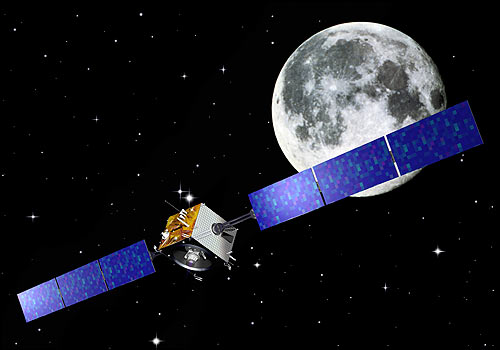The spacecraft was launched 14 months ago and circled the earth thousands of times until it gained enough speed to reach the moon using an innovative ion engine

The European spacecraft Smart-1 entered orbit around the moon. It is the first European spacecraft to be launched to the Moon. "Europe has reached the moon, we are in lunar orbit," said Prof. David Southwood, the scientific director of the European Space Agency (ESA).
On Monday, the spacecraft's ion engine began to operate, an operation that will continue continuously until Thursday to help the spacecraft be captured by the moon's gravity.
The spacecraft will circle the moon in a spiral-like manner until it reaches its final orbit on February 1, 2005. This is an elliptical orbit at a distance of 300-3000 km from the surface of the moon. This was announced by the project scientists at a press conference on Tuesday.
Dr. Bernard Poing, the chief scientist of the European Space Agency, said that the data collected by Smart-1 will be used by the next generation of space scientists.
The special engine test was the main purpose of the spacecraft. The engine works by releasing a beam of ionized xenon atoms from the back of the spacecraft.
Smart-1 will start circling the moon at an altitude of 300 km from Monday
Avi Blizovsky, 14/10/2004
It's been a long journey, but the first European mission to the moon is getting closer to its goal. The Smart-1 spacecraft, launched by the European Space Agency ESA on September 27, 2003, will enter lunar orbit on November 15.
In January, the spacecraft will launch its comprehensive X-ray study of the moon's surface, giving scientists clues about the surface's composition and age. This geological map will help scientists understand exactly how the moon was formed.
The Smart-1 spacecraft, which measures about the size of a household washing machine, uses an innovative propulsion method that brought it to the moon by blowing gas. The spacecraft carries solar collectors that convert sunlight into electricity, which is used to remove electrons from xenon atoms. This process produces electrically charged ions that are accelerated through a magnetic field and ejected from the back of the spacecraft, providing it with a gentle push similar to the weight of a very thin coin in the palm of your hand. "This is the first time an ion engine has been used to escape the Earth's gravity," says Bernard Poing, who heads the scientific team of the Smart-1 spacecraft at the European Space Agency's Space Science Department in Noordwijk, the Netherlands.
The engines of conventional spacecraft rely mainly on chemical reactions to produce gas, which propels the spacecraft as it is sucked out through the engines, just like a balloon from which air flies through the room. But in space, mass means money. A vessel driven by a chemical engine must carry with it all the materials necessary to carry out the chemical reaction (mostly hydrogen and oxygen). Smart-1 only carries a Zenon and this makes it light and cheap.
The success of SMART-1, which stands for Small Missions for Advanced Research in Technology, in reaching the moon demonstrates the ability of future spacecraft that could use the same engine to reach Mercury and Mars, Poing said.
A lot of scientific work is expected for the Smart-1 spacecraft during the two years it will spend orbiting the moon. It will demonstrate a new type of camera - a Compact X-ray Spectrometer (D-CIXS), which will perform chemical mapping of the surface of the Moon and may finally reveal the answer to the question of whether the Moon was once part of the Earth.
"We still don't know if the Earth and the Moon formed from the same place." says Manuel Grande, a space scientist at the Rutherford Appleton Laboratory (Rutherford Appleton) near Oxford, UK, who is responsible for the D-CIXS instrument. Many scientists believe that the Moon was formed after a Mars-sized object collided with the Earth 4.6 billion years ago. By comparing the ratios of the chemical elements On the moon and the earth it will be possible to confirm this theory, says Grande.
The hunt for the iceSmart-1 will also carry a high-definition camera that will photograph potential landing sites for robotic or even manned missions. And it will look for ice in the craters near the south pole of the moon, using an infrared spectrometer. "These craters haven't seen sunlight for billions of years." says Grande, who adds that this ice could be a vital resource for a manned base.
The spacecraft that cost 85 million dollars weighs 370 kg and it made many spiral orbits around the earth during which it built up enough speed to reach the moon. In total, it covered 80 million kilometers over 13 months, compared to the four days it took the Apollo 11 spacecraft to cover the 400 kilometer distance on the first lunar mission.
